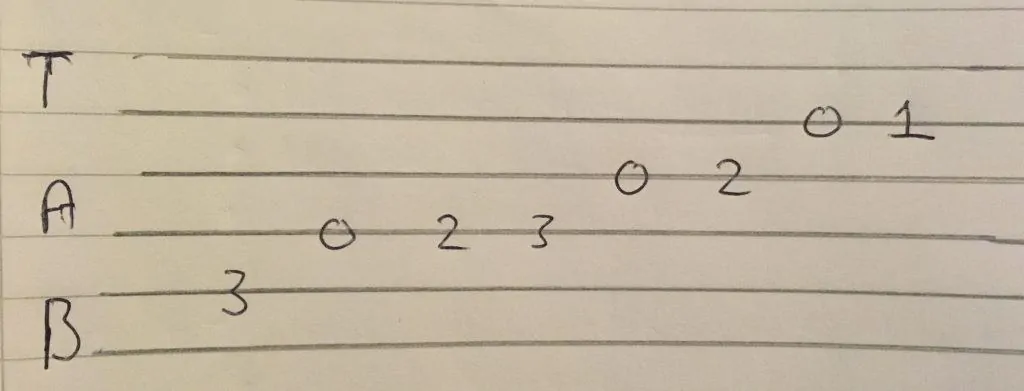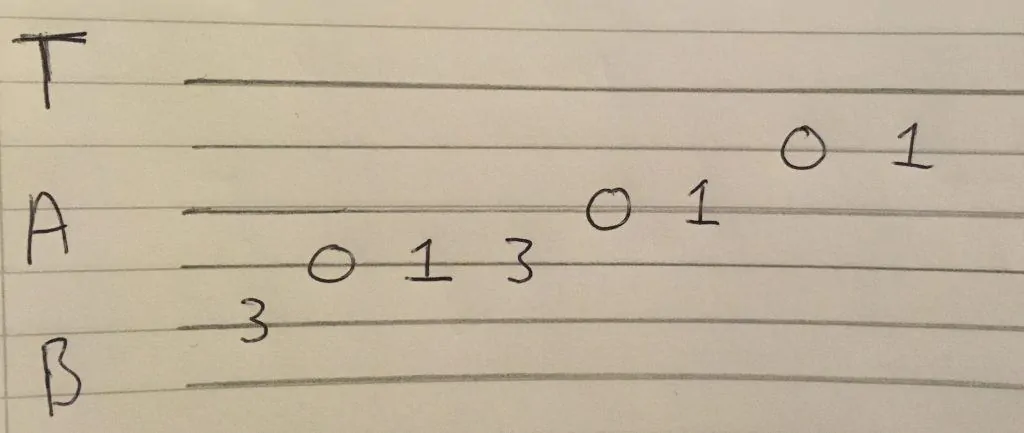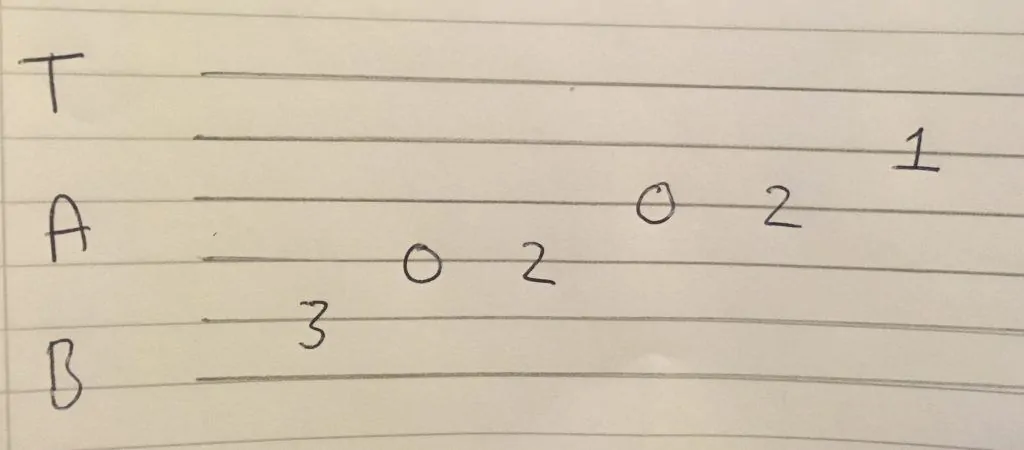When playing guitar, playing chords well and reading tab with precision are your first steps, but the ability to improvise will soon become important whether you’re playing a guitar solo or writing a song.
In this important guide you will learn:
- What improvisation is
- Some scales to use
- How to employ modes
- How to bend strings
- How to slide between frets
- Chordal improvisation
- A few advanced techniques
If you’re looking for somewhere to start with improvisation, then look no further…
What is improvisation?
Improvisation is the creation of on the spot, unprepared, spontaneous music. Typically, your improvisation will match the key/time signature of the accompaniment (though, of course, improvisation can be performed on solo guitar too). Scales and modes can help you to choose your notes, string bends and fret sliding can give you new ways to change note. You can even improvise your own chord sequences! Advanced techniques such as sweep picking, tapping and pinch harmonics can help your improvisation look even more impressive.
Scales and Modes
A scale is a set of notes ordered by pitch. In their simplest form, they match a key signature. When improvising, your choice of scale is the biggest factor in the tone your improvisation takes. Normally, you’ll use scales that match the current key (decided by the chords that are accompanying) but switching between scales as you play is very common practice.
For the sake of simplicity, all of the examples we look at during this section will be based around ‘C’- but can of course be transposed.
- Major Scale: (C, D, E, F, G, A, B, C)
The major scale is a made up of the white notes of a piano from C-C and will give a bright, uplifting sound to your improvisation. Most of the time, when playing in a major key, the matching major scale should be used for improvisation.
- Natural Minor Scale: (C, D, Eb, F, G, Ab, Bb, C)
The natural minor scale adds a minor 3rd, minor 6th and minor 7th. When playing in a minor key, you’ll probably want to use the minor scale (of one of its variants below) of the same key.
- Harmonic Minor Scale: (C, D, Eb, F, G, Ab, B, C)
The harmonic minor scale raises the minor 7th of the natural minor scale- and therefore can, in most cases, be used interchangeably. Raising the 7th in a minor scale will add an unsettling aspect to your improvisation.
- Melodic Minor Scale: (C, D, Eb, F, G, A, B, C)
The melodic minor scale is an interesting one, as it both essentially a major scale with a minor 3rd, or a minor scale with a raised 6th and 7th. This gives it an unsettling sound when employed in a minor key, but is also helpful when playing major key blues/jazz, as the minor 3rd can be heard as a ‘blue’ note.
- Major Pentatonic Scale: (C, D, E, G, A)
The major pentatonic scale is a simplified version of the major scale. It omits the potential of using the dissonant intervals of a minor 2nd and a tritone- go for this one if you’re looking for a really smooth, consonant sound.
- Minor Pentatonic Scale: (C, Eb, F, G, Bb)
The minor pentatonic scale is a simplified version of the minor scale. It works in much the same way as the major pentatonic, but its use would be a lot more suited to improvisation in a minor key.
- Chromatic Scale: (C, C#, D, Eb, E, F, F#, G, G#, A, Bb, B, C)
The chromatic scale uses all 12 notes, and therefore has a very unusual, dissonant sound. Typically, you’d only use this scale temporarily to add a bit of flavour to a passage, but if you’re playing something particularly experimental or avant-garde, then give it a try.
Technically everything we’ve already looked at is a mode, but the scales we’ll talk about below are more often referred to as modes than scales, like the above. A mode is a set of notes with distinct melodic characteristics. There are hundreds, but we’ll just take a look at the most common/useful.
- Dorian Mode: (C, D, Eb, F, G, A, Bb, C)
The Dorian mode is a minor scale with a raised 6th. This would typically be used in a piece where the chord II (D minor in a C minor scale) is a major instead of diminished, but can be used to give a slightly brighter tone to a minor scale.
- Phrygian Mode: (C, Db, Eb, F, G, Ab, Bb, C)
The Phrygian mode is a version of the minor scale that adds a minor 2nd. This can be used to darken the scale, adding a chromatic element and will often disguise the tonic note.

- Lydian Mode: (C, D, E, F#, G, A, B, C)
The Lydian mode is a version of the major scale, which adds a #4th to create an extra level of brightness. This can be used particularly when chord VII (B minor in C major scale) is a minor chord rather than a diminished chord.
- Mixolydian Mode: (C, D, E, F, G, A, Bb, C)
The Mixolydian mode is often used in jazz and blues, adding a minor 7th to the major scale. It can often be used as a ‘blue’ note, and will be a welcome addition to your improvisation when chord VII is a bVII (Bb in a C major scale)
- A Few Other Modes:
Other helpful modes include the Locrian (used for especially dark improvisation, as it includes a b2nd and b5th), the Phrygian Dominant (which adds a major 3rd to the Phrygian mode) and the whole tone scale (which gives a dreamy, otherworldly sound due to its intervals made up exclusively of whole tones).
When choosing what scales/modes to use in your improvisation, be careful to look out for the key you’re playing in, the chords being used, and the mood you’re trying to set.
String Bending
String bending is a technique used to ‘bend’ a note up to a new pitch. It achieves a smooth sound that makes every frequency between the starting and ending note audible, rather than by note-to-note like changing fret would. This makes string bending a valuable technique, as it adds a new form of expression and way to add notes. A word of warning! Don’t bend your strings too far– they can snap.
- Led Zeppelin’s ‘Stairway To Heaven’ is one of the most famous examples of string bending in action, with the opening note being bent up by 2 semitones. Fun Fact: Led Zeppelin reunited for a one off show in 2007- over 2 million people tried to get one of the 16,000 available tickets.
- Cream’s ‘White Room’ ends with a bend-heavy solo from Eric Clapton, whose bluesy playing style often lends itself naturally to a lot of bendy playing. Fun Fact: Eric Clapton went on to have an immensely successful solo career, with tunes such as ‘Layla’ and ‘Tears In Heaven’
Fret Sliding
Sliding between frets is another simple concept, and one of the easiest to pull off. Simply press down on one fret, play the note and then as it rings out, slide your hand up or down the string to land on a new fret. You could approach this techniques from various angles, ranging from a slow slide all the way up the neck, to a quick slide between next-door frets. Pay attention to the key and be careful where you land, the note might not work!
- Chuck Berry’s ‘Johnny B. Goode’ is full of sliding in its improvisation. Chuck Berry’s clean tone contrasts a lot of overdriven uses of sliding, and adds a vocal-like quality to his playing. Fun Fact: Berry wrote multiple other pieces based around the Johnny B Goode character.
- Guthrie Govan’s ‘Waves’ is technically not an improvised piece, but it does show off one of the finest examples of sliding done well. This video shows Guthrie’s hands running up and down the neck, giving off one of the smoothest sounds you’ll hear in music. Give something like this a try when you’re a bit more comfortable with sliding. Fun Fact: Guthrie’s career has seen him guest with many well-known artists from Steven Wilson to Dizzy Rascal.
Tapping
Tapping does exactly what it says on the tin. Rather than using your right hand to strum/pick the strings, you bring it up to the neck and tap the frets. Typically, when tapping you’ll want to combine it with pull offs and hammer ons to add speed and changes in note to your playing. Overdrive is key to successful tapping, as it makes the guitar more sensitive and allows the tapped notes to be heard. Make sure you get yourself a good pedal!
- Van Halen’s ‘Eruption’ is one of the most famous examples of tapping. The speed at which he combines hammer ons and pull offs are key to the wall of sound he creates. Fun Fact: This solo is unique in the fact it is almost completely unaccompanied, yet is widely regarded as one of the greatest guitar solos of all time.
- Ozzy Osbourne’s ‘Crazy Train’ features the iconic playing of Randy Rhodes, with a sudden, speedy solo. This is an important example as it shows off tapping’s ability to bring out chromaticism without it being overt or disruptive. Fun Fact: Randy Rhodes was a founding member of the band Quiet Riot.
Sweep Picking
Sweep picking is the idea of ‘sweeping’ your picking hand down the strings, and playing a series of notes with the fretting hand. Its most often used to add speed to your improvisation, and you can combine it with other techniques such as fret sliding- this will add even more speed to your playing! A few things you need to look out for are some potential problems, such as muting.
- Deep Purple’s ‘April’ is a great example of sweep picking in action, with Richie Blackmore’s fast arpeggios filling the track in both its improvised and pre-written sections. Fun Fact: Richie Blackmore is often considered one of the finest metal/classical fusion artists.
- Yngwie Malmsteen’s ‘Far Beyond The Sun’ is taken from an album that uses sweep picking throughout virtually every track. The legendary guitarist is known for his immensely fast playing technique, and this track is definitely no exception. Fun Fact: Malmsteen was the second guitarist to be honoured with a signature Fender, after Eric Clapton.
Pinch Harmonics
Pinch harmonics are an extended technique that can be used to add expression or interest to your playing. They sound like a sudden, high pitched squeal as it stops something called a fundamental frequency being heard, and instead only allows different pitches called harmonics to ring out. If you feel like making this sound, then hold your pick so that less of the end is protruding and your thumb or finger hits the string just after your pick does. Be careful with this one, as it risks deadening/muting the note entirely, which would (in most cases) give you an unpleasant and unsatisfying silence. Pinch harmonics are often used in rock/metal music.
- Pink Floyd’s ‘Comfortably Numb’ is one of the most famous examples of pinch harmonics in a solo. Combined with the heavy distortion, this pinch harmonic gives off a high pitched squeal before the first note is heard. Fun Fact: The solo used in the studio version was an amalgamation of various improvisations David Gilmour did during sessions for ‘The Wall’.
- Zakk Wylde’s ‘Farewell Ballad’ is full of pinch harmonics, and this video even helps you to see how Zakk Wylde achieves the sound. Notice the position of his thumb on the guitar pick as he plays notes with harmonics. Fun Fact: Zakk Wylde was ex-Black Sabbath singer’s Ozzy Osbourne’s lead guitarist when Randy Rhodes passed away.
Chordal Improvisation
Improvising chords is often a challenge to guitarists, as you have more than one note to make fit above the accompaniment. Therefore, it’s not something you’ll hear all that often, but it’s still great to have it in your arsenal of techniques. The idea is pretty simple- improvising chords rather than single notes. Doing it successfully is a lot harder than you think! Typically, chordal improvisation is normally a lot more common in jazz than other styles. One good tip to keep in mind for harmonic improvisation, is that the note at the top of the chord will be the leading note (AKA the note that’s ‘going somewhere’) and the rest of the notes are adding colour. Oh, and maybe brush up on your chords first.
- Wes Montgomery’s ‘Round Midnight’ see’s the influential jazz guitarist employing his distinctive technique. This video actually allows us to see his encyclopaedic grasp of chord shapes and hand positions, something you’re going to need to work on before taking it on in your improvisation. Fun Fact: This piece was originally composed by jazz pianist Thelonious Monk.
- Joe Pass’ ‘How High The Moon’ is another exceptional jazz tune, which highlights the use of the note at the top of the chord as the ‘leading tone’. Fun Fact: Joe Pass is known for his work with jazz greats such as Oscar Peterson and Ella Fitzgerald.
Check out this video. It shows off most of the techniques we’ve mentioned in this guide.
A few final thoughts:
- Remember to think about the style you’re improvising in. Jazzy? Virtuosic? Creepy? Apply techniques based on this.
- In almost every scenario (especially when you’re starting out with improvisation) your choice of scale(s) is important. Make sure you check your key and chord sequence so you know what will work.
- Combining these techniques is normally a great idea- but make sure what you’re about to do is possible. If you’re planning on moving from a fast, low, sweep picking arpeggio to some high, jazzy extended chords, give it a thought first. How’s it going to sound?
- Feel it! Your improvisation is only going to sound as good as your personal connection to what you’re creating.

Dan is a music tutor and writer. He has played piano since he was 4, and guitar and drum kit since he was 11.
He plays a Guild acoustic and a Pacifica electric. He has been sent to many festivals and gigs (ranging from pop to extreme metal) as both a photographer and reviewer, with his proudest achievement so far being an interview he has with Steve Hackett (ex-Genesis guitarist).
He ranks among his favourite ever guitarists, alongside Guthrie Govan, Jimmy Page, Jimi Hendrix, David Gilmour and Robert Fripp. His favourite genre of music is progressive rock, which he likes to use as a reference point in my teaching, thanks to its huge complexity in structure, rhythm and harmony. However, he is also into a lot of other genres including jazz, 90’s hip-hop, death metal and 20th century classical music.








